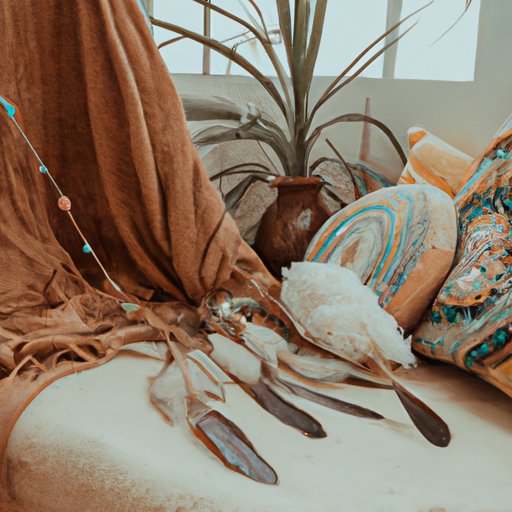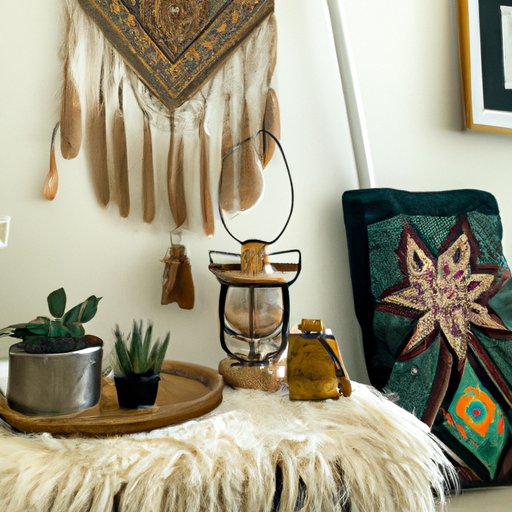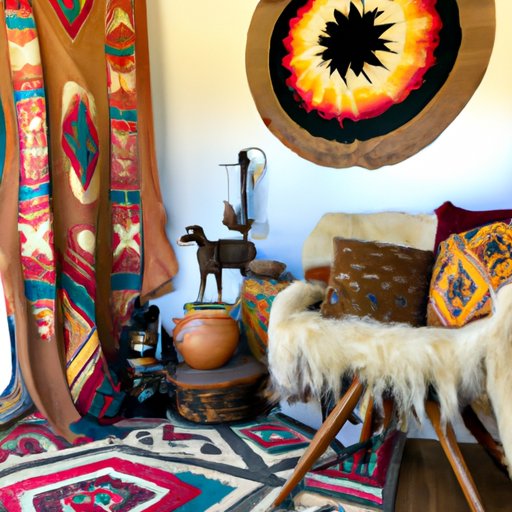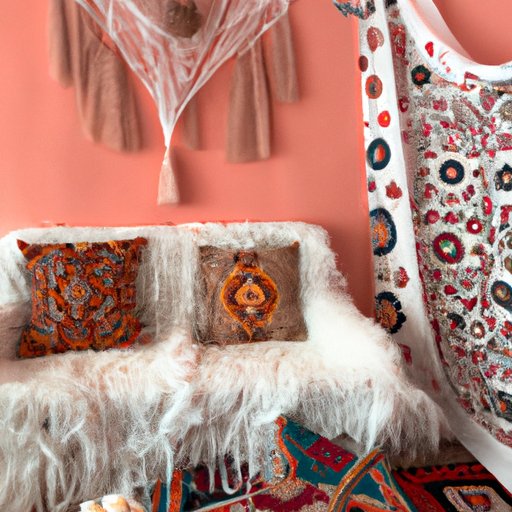Introduction
Boho interior design is a trend that has been growing in popularity in recent years. This style of decorating incorporates eclectic elements from different cultures and eras, creating unique and vibrant spaces. The term “boho” is derived from the word “bohemian” and is generally associated with an eclectic, global approach to decorating. It is often referred to as “boho chic” or “bohemian style” and is characterized by its use of bright colors, textiles, and patterns.
At its core, boho interior design is about creating a space that is comfortable, inviting, and full of personality. It embraces the idea of mixing and matching different pieces from different eras and cultures, resulting in an interesting and eclectic aesthetic. From bold colors and vibrant patterns to vintage furniture and unique accessories, there are many ways to incorporate boho style into your home.

Exploring the Elements of Boho Interior Design
When it comes to boho interior design, there are several key elements that help to create the look. These include color palettes, textiles and patterns, furniture and accessories, and more.
Color Palettes
A key element of boho interior design is the use of color. Bright, bold colors are often used to create a vibrant, energetic atmosphere. Common color combinations for boho style include earthy tones such as terracotta, olive green, and mustard yellow, as well as jewel tones like emerald green and sapphire blue. Additionally, black and white can be used to create contrast and add visual interest.
Textiles and Patterns
Textiles and patterns are essential for creating a boho look. Textiles such as cotton, linen, and wool can be used to add texture and warmth to a room, while patterns like stripes, florals, and ikat can be used to add visual interest. Additionally, textiles and patterns can be used to tie different elements of the room together, creating a cohesive look.
Furniture and Accessories
Furniture and accessories are also important for creating a boho look. Furniture should be chosen for its comfort and functionality, as well as its aesthetic appeal. Vintage furniture pieces, such as armchairs and sofas, can be used to give a room a lived-in, cozy feel. Accessories such as rugs, pillows, and throws can be used to add color and pattern to the room. Plants and artwork can also be used to add visual interest and bring life to a space.
Boho Chic: A Guide to Bohemian Interior Design
The history and evolution of boho style interiors can be traced back to the late 19th century. During this time, the bohemian lifestyle was embraced by artists and creatives who sought to live a life free from societal conventions. As a result, their homes were often filled with colorful fabrics, unique furniture pieces, and eclectic artworks.
Today, boho style interiors have become increasingly popular. Characteristics of boho style include the use of bright colors, layered textiles, and vintage furniture. Additionally, boho style interiors often feature eclectic artworks, plants, and other decorative items.

How to Achieve a Boho Look in Your Home
Achieving a boho look in your home doesn’t have to be expensive or complicated. Here are some tips for incorporating boho style into your home:
- Start with a neutral base. Choose a neutral color palette for walls, floors, and furniture to create a foundation for the rest of the room.
- Add texture and pattern with textiles. Layer rugs, throws, and pillows to add texture and pattern to the room.
- Incorporate vintage furniture and accessories. Find unique pieces at thrift stores or flea markets to add character to the room.
- Display artwork. Hang artwork on the walls to add visual interest and bring life to the room.
- Bring in plants. Add plants to the room to add color and texture and bring a sense of life to the space.
Creating a boho-inspired room on a budget can be done with a few simple steps. Start by choosing a neutral color palette for walls and furniture. Next, add texture and pattern to the room with textiles and accessories. Finally, find unique pieces at thrift stores or flea markets to add character to the room. With these steps, you can create a stylish and inviting boho-inspired room without breaking the bank.

Mixing Vintage and Modern Styles for a Boho Interior Design
One of the best things about boho interior design is that it allows you to mix old and new. Combining vintage and modern styles can create a unique and interesting look. For example, a vintage sofa paired with a modern rug and artwork can create a stylish and inviting living room.
Examples of boho-modern interior design can be seen in many homes today. A great example is the use of vintage furniture pieces mixed with modern accents such as lighting fixtures and wall art. Additionally, boho-modern interiors often feature natural elements such as wood and stone to create a warm, inviting atmosphere.
Conclusion
Boho interior design is all about creating a unique and inviting space that reflects your personal style. By combining vintage and modern styles, you can create a one-of-a-kind look that is both stylish and comfortable. Whether you’re looking to add a touch of boho chic to your home or go all out with a full-on bohemian makeover, there are plenty of ways to achieve a beautiful boho look.
(Note: Is this article not meeting your expectations? Do you have knowledge or insights to share? Unlock new opportunities and expand your reach by joining our authors team. Click Registration to join us and share your expertise with our readers.)
